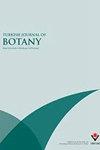Rubisco与植物的非生物胁迫:当前评估
IF 1.5
4区 生物学
Q3 PLANT SCIENCES
引用次数: 2
摘要
:非生物胁迫是严重的环境因素,阻碍了世界各地许多作物的生产。其后果是难以满足日益增长的世界人口的需求。除了其他负面影响外,光合作用的减少是非生物胁迫的一个重要特征。非生物胁迫在许多方面限制光合作用。核酮糖1,5-二磷酸羧化酶/加氧酶(Rubisco)含量和活性的降低是非生物胁迫影响光合作用的重要途径之一。Rubisco是光合作用的CO2固定酶,也催化光呼吸碳氧化。该酶具有较低的周转率,并且还能够应对O2的竞争性抑制。因此,操纵酶以促进光合作用一直是科学家们的目标,尤其是在压力环境中。根据近年来的研究,本文对非生物胁迫对Rubisco的有害作用机制进行了综述。此外,还评估了Rubisco在各种非生物胁迫下生长良好的普遍方式。这篇综述文章还概述了推广提高Rubisco对非生物胁迫耐受性的现有方法的可行方法,以生产更多具有更高抗逆性的作物。本文章由计算机程序翻译,如有差异,请以英文原文为准。
Rubisco and abiotic stresses in plants: Current assessment
: Abiotic stresses are serious environmental factors militating against the production of many crops around the world. The consequence of this, is the difficulty of meeting the demands of the increasing world population. Aside from other negative effects, reduction in photosynthesis is an important feature of abiotic stresses. Abiotic stresses limit photosynthesis in a number of ways. The reduction in ribulose 1, 5-bisphosphate carboxylase/oxygenase (Rubisco) content and activity is one of the paramount ways through which abiotic stresses affect photosynthesis. Rubisco is the CO 2 fixing enzyme of photosynthesis and also catalyses the photo-respiratory carbon oxidation. The enzyme has low turnover and also copes with competitive inhibition by O 2 . Hence, manipulating the enzyme in order to boost photosynthesis has been the target of scientists, especially in stressed environments. Based on recent studies, the mechanism of the harmful effects of abiotic stresses on Rubisco is examined in this review. In addition, the prevalent ways through which Rubisco can be made to thrive well despite the various abiotic stresses are evaluated. This review paper also outlines practicable approaches to promote existing ways of enhancing Rubisco tolerance to abiotic stresses in order to produce more crops with higher stress resilience.
求助全文
通过发布文献求助,成功后即可免费获取论文全文。
去求助
来源期刊

Turkish Journal of Botany
PLANT SCIENCES-
CiteScore
2.90
自引率
5.60%
发文量
31
审稿时长
6-12 weeks
期刊介绍:
The Turkish Journal of Botany is published electronically 6 times a year by the Scientific and Technological Research Council of Turkey (TÜBİTAK) and accepts manuscripts (in English) covering all areas of plant biology (including genetics, evolution, systematics, structure, function, development, diversity, conservation biology, biogeography, paleobotany, ontogeny, functional morphology, ecology, reproductive biology, and pollination biology), all levels of organisation (molecular to ecosystem), and all plant groups and allied organisms (algae, fungi, and lichens). Authors are required to frame their research questions and discuss their results in terms of major questions in plant biology. In general, papers that are too narrowly focused, purely descriptive, or broad surveys, or that contain only preliminary data or natural history, will not be considered (*).
The following types of article will be considered:
1. Research articles: Original research in various fields of botany will be evaluated as research articles.
2. Research notes: These include articles such as preliminary notes on a study or manuscripts on the morphological, anatomical, cytological, physiological, biochemical, and other properties of plant, algae, lichen and fungi species.
3. Reviews: Reviews of recent developments, improvements, discoveries, and ideas in various fields of botany.
4. Letters to the editor: These include opinions, comments relating to the publishing policy of the Turkish Journal of Botany, news, and suggestions. Letters should not exceed one journal page.
(*) 1. Raw floristic lists (of algae, lichens, fungi, or plants), species descriptions, chorological studies, and plant sociology studies without any additional independent approaches.
2. Comparative morphology and anatomy studies (that do not cover a family, tribe, subtribe, genus, subgenus, section, subsection, or species complexes with taxonomical problems) without one or more independent additional approaches such as phylogenetical, micromorphological, chromosomal and anatomical analyses.
3. Revisions of family, tribe, genus, subgenus, section, subsection, or species complexes without any original outputs such as taxonomical status changes, IUCN categories, and phenological and ecological analyses.
4. New taxa of all plants without any additional independent approaches such as phylogenetical, ecological, chromosomal, chorological and correlational analyses in addition to a detailed macro- and micro-morphological descriptions with quality field and microscopic illustrations of taxonomically important structures and identification key in the taxonomic group.
New records of all plants without any additional independent approaches such as phylogenetical, ecological, chromosomal, chorological and correlational analyses in addition to a detailed macro- and micro-morphological descriptions with quality field and microscopic illustrations of taxonomically important structures and identification key in the taxonomic group may be accepted for peer review if they contain 3 or more new records or taxonomical status update, such as lectotypification, new combinations, transfers, revivals and synonyms.
5. New taxa of algae, lichens, and fungi without any additional independent approaches such as phylogenetical, ecological, chromosomal, chorological and correlational analyses in addition to a detailed macro- and micro-morphological descriptions with quality field and microscopic illustrations of taxonomically important structures and identification key in the taxonomic group.
New records of algae, lichens, and fungi without any additional independent approaches such as phylogenetical, ecological, chromosomal, chorological and correlational analyses in addition to a detailed macro- and micro-morphological descriptions with quality field and microscopic illustrations of taxonomically important structures and identification key in the taxonomic group may be accepted for peer review if they contain 5 or more new records or taxonomical status update, such as lectotypification, new combinations, transfers, revivals and synonyms.
 求助内容:
求助内容: 应助结果提醒方式:
应助结果提醒方式:


